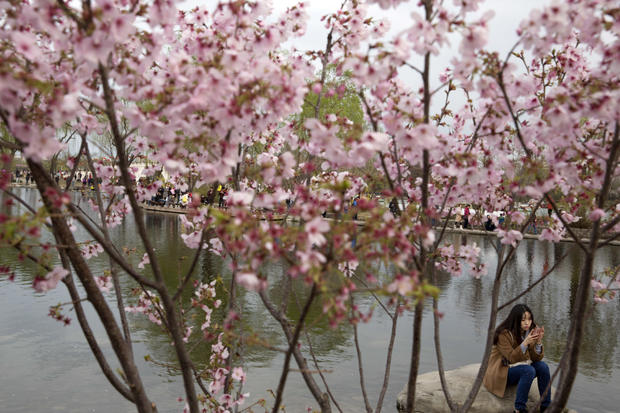How megacities can save megabucks: Plant trees
Trees in urban areas can lower residents' blood pressure, reduce stress and contribute to an overall sense of well-being. But did you know they can also save cities money?
In the world's megacities, or those with more than 10 million people, every dollar invested in planting a tree results in an average return on investment of $2.25, according to a recent study from researchers led by Theodore Endreny, chair and professor at the College of Environmental Science & Forestry at the State University of New York at Syracuse.
That translates into savings of more than $500 million a year for the planet's 10 biggest cities, including reductions of gases and particulates in the air, lower wastewater processing costs, and decreased heating and cooling costs.
About "90 percent of that is attributed to health care costs from disease related to particulate matter that gets inhaled into our lungs and causes a whole suite of problems," Endreny said in an interview. Major components of particulate matter include sulfate, nitrates, ammonia, sodium chloride, black carbon, mineral dust and water.
None of the study's estimates of the gains from planting trees count mental health benefits, such as lower levels of the stress hormone cortisol. So the returns may be vastly greater than $500 million Endreny said.
"If you really think about depression or other mental health issues, it really can impact days active at work, which most governments are struggling with how do you reduce that inactivity, those sick days and reduced performance at work," he said.
On average, about 20 percent of the biggest cities' urban center is covered by forest canopy, based on an aerial survey of 35 megacities, according to Endreny. New York City had the most tree-canopy covered space at 35 percent. On the other end of the spectrum, only 1 percent of Lima, the capital of Peru, is covered by canopy.
The study focused on the impact of trees in 10 cities: Beijing, Buenos Aires, Cairo, Istanbul, London, Los Angeles, Mexico City, Moscow, Mumbai and Tokyo. They are spread across five continents and represent five different biomes.
Tokyo had the biggest natural habitat at more than 11,600 square miles, Cairo the smallest (727 square miles). The researchers used aerial imagery from 2016 for all cities except London, which was based on October 2015 data.
Cities need more trees than ever in part because more people are moving to urban areas, as well as because of climate change. A recent United Nations report found 4.2 billion of all 7.6 billion people on earth now call an urban area home. The UN also predicted the number of megacities will reach 41 by 2030, up from 31 in 2016.
That means more polluted air and fewer surfaces water can penetrate. The World Health Organization this month estimated that nine of 10 people worldwide breathe polluted air, with more than 7 million deaths tied to that pollution. Generally, the wealthier the country, the lower the ambient air pollution. In Europe's high-income cities, for example, pollution was shown to cut between two months and two years off a person's life expectancy, the WHO said.
Politicians are paying more attention to cities' air quality, according to Maria Neira, WHO's director of the Department of Public Health, Social and Environmental Determinants of Health.
"The increase in cities recording air pollution data reflects a commitment to air-quality assessment and monitoring," she said on WHO's website. "Most of this increase has occurred in high-income countries, but we hope to see a similar scale-up of monitoring efforts worldwide."
In the U.S., a different study released in May shows American cities and big towns are losing some tree benefits amid surging development and more extreme weather, like hurricanes. U.S. urban tree cover fell slightly to 39 percent, from 40 percent, between 2009 and 2014.
Over the same timespan, meanwhile, so-called "impervious" cover -- areas like pavement or plastic that don't absorb rainfall -- climbed a percentage point to about 27 percent. At that rate, the U.S. tree cover loss amounts to about 175,000 acres, or 36 million trees, with a cost of at least $96 million, the study said.
Factors contributing to the loss of trees in U.S. cities include rising urban population, natural tree aging, storms, insect damage, fire and property development that shifts wooded areas to lawns, lead researcher David Novak of the Forestry Service told Scientific American.
States with the biggest loss in urban tree cover included Oklahoma, Rhode Island, Oregon, Georgia. Washington D.C. was also in the top five list. Just three states, Mississippi, Montana and New Mexico saw increased urban tree cover over the six-year study period.
One challenge for cities looking to increase their tree canopy can be waning attention to the issue once trees are planted, Endreny said. Tending older trees can also feel less essential, but is important because young trees can take years to grow into the kinds of canopies that provide the largest environmental, health and financial benefits.
"Many cities are losing cover because as development continues or ages out, typically larger trees are the ones removed," he said.
Researchers calculate what trees cost or save in part using i-Tree, software developed by the U.S. Forest Service that includes analysis and benefit assessment tools that's used globally.
Last fall, the Forest Service teamed with the nonprofit American Forests and the National Association of Regional Councils, a community development organization, to form the Vibrant Cities Lab, a resource for communities looking to bolster tree cover and tend to their city or town.
"It was designed to really bring together the latest research, best practices, practical expertise and a step-by-step tool kit to really speak to non-forestry people and really give them the tools to incorporate into their forestry projects," said Ian Leahy, director of urban forest programs at the non-profit American Forests. "It includes research, both positive and negative, around tree canopies in cities so people can make the best decisions possible."




